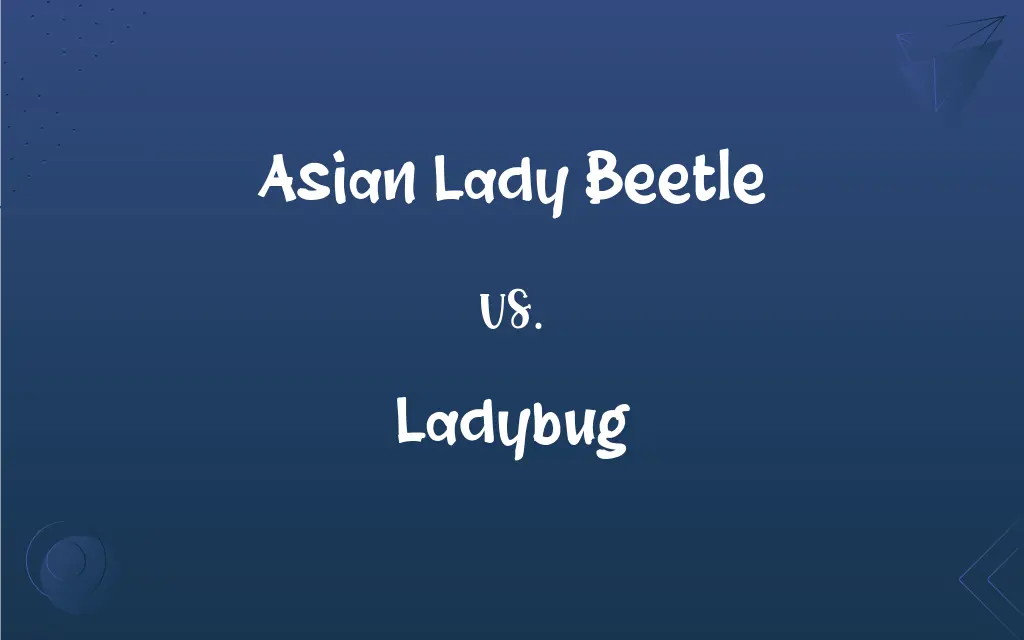Asian Lady Beetle vs. Ladybug: What's the Difference?
Edited by Aimie Carlson || By Harlon Moss || Updated on October 9, 2023
Asian lady beetles are larger, vary in color, and can be invasive, while ladybugs (a general term for Coccinellidae family members) are often smaller, red with black spots, and native to multiple regions.

Key Differences
The Asian lady beetle and the ladybug are both members of the Coccinellidae family, which consists of small beetles commonly known as ladybirds or lady beetles. While the term "ladybug" is colloquially used in North America to refer to any beetle from this family, the Asian lady beetle is a specific species, Harmonia axyridis. In contrast, the term "ladybug" could refer to any of the thousands of species within the Coccinellidae family, not just the Asian variant.
The Asian lady beetle was introduced in North America as a biological control agent to manage pests, while many native ladybug species have been present on the continent for much longer. This distinction between the Asian lady beetle and the generic ladybug is critical because the former is sometimes considered an invasive species in certain regions. Its introduction has led to challenges in ecosystems where native ladybugs have traditionally played a role.
Visually, there are slight differences between the Asian lady beetle and the classic ladybug. The Asian lady beetle can range in color from yellow-orange to red, often with multiple black spots. However, a key identifier is the "M" or "W"-shaped marking behind their head. On the other hand, ladybugs, depending on the species, can be red, orange, yellow, or even black, with varying numbers of spots. While they might look similar at first glance, keen observers can spot differences between the Asian lady beetle and other ladybugs.
In terms of behavior, the Asian lady beetle has a tendency to aggregate in large numbers during the fall, often invading homes to overwinter. This behavior is in contrast to many native ladybug species, which might overwinter under leaves or in other natural shelters. The distinction between the habits of the Asian lady beetle and the classic ladybug can sometimes lead to frustrations for homeowners dealing with infestations.
Both the Asian lady beetle and the ladybug are predators of soft-bodied insects like aphids, making them beneficial for natural pest control. Gardeners often welcome ladybugs due to their helpful role in managing plant pests. However, the Asian lady beetle, because of its aggressive nature and large populations, can sometimes outcompete native ladybugs for food. This difference in competitive behavior further distinguishes the Asian lady beetle from the general ladybug population.
ADVERTISEMENT
Comparison Chart
Scientific Name
Harmonia axyridis
Coccinellidae (family level)
Size
Generally larger, around 7mm in length
Size can vary, often smaller
Color Variations
Can be orange, yellow, or red, with a varying number of spots
Typically red with black spots, but variation exists
Native/Invasive Status
Invasive in North America and Europe
Various species native to many regions
Aggressiveness
Can be more aggressive, sometimes biting humans
Typically non-aggressive towards humans
ADVERTISEMENT
Habitat Invading
Tend to invade homes in winter
Usually do not invade homes en masse
Interaction with Humans
Can emit an unpleasant odor and stain surfaces when threatened or crushed
Typically considered beneficial and not a nuisance to humans
Preferred Habitat
Varied; may be found in buildings, on crops, and in wild landscapes
Diverse habitats including gardens, fields, and forests
Predatory Behavior
Predatory, often consuming pests but also non-pest insects
Predatory, usually feeding on aphids and other small pests
Asian Lady Beetle and Ladybug Definitions
Asian Lady Beetle
Aggressive Tendencies.
Unlike many of its relatives, the Asian lady beetle might bite and is often considered to be more aggressive.
Ladybug
Beloved Beetle.
The ladybug, with its iconic red and black spotted appearance, is often adored by people of all ages.
Asian Lady Beetle
Color Variability.
The Asian lady beetle can appear in a range of colors and spot numbers, making them somewhat variable in appearance.
Ladybug
Symbolic Insect.
In various cultures, spotting a ladybug is often considered a sign of good luck.
Asian Lady Beetle
Habitat Invasion.
The Asian lady beetle is known to invade homes during the winter months, seeking warmth and shelter.
Ladybug
Safe for Humans.
Unlike some of its relatives, the ladybug is harmless to humans and does not invade homes in large numbers.
Asian Lady Beetle
Invasive Species.
The Asian lady beetle, originally from Asia, is now found throughout North America and Europe.
Ladybug
Aphid Predator.
Gardeners appreciate the ladybug for its appetite for aphids, a common pest in gardens.
Asian Lady Beetle
Predatory Insects.
Despite being a pest to humans at times, the Asian lady beetle helps control pest populations by preying on them.
Ladybug
Global Resident.
The ladybug can be found in numerous regions across the world, adapting to various environments.
Ladybug
Any of numerous small, rounded, usually colorful beetles of the family Coccinellidae, often reddish with black spots and feeding primarily on other insects, including pests such as scale insects and aphids. Also called lady beetle, ladybird.
Ladybug
(North America) ladybird.
FAQs
Are ladybugs and Asian lady beetles the same?
No, while similar, they are different; Asian lady beetles can be more aggressive and invasive.
Are ladybugs beneficial to gardens?
Yes, they consume pests like aphids, benefiting plant life.
What is the lifespan of an Asian lady beetle?
Approximately one to three years.
Can ladybugs be other colors besides red?
Yes, ladybugs can also be orange, yellow, or even black.
Do ladybugs hibernate during winter?
Yes, ladybugs enter diapause (a form of hibernation) in winter.
What do Asian lady beetles eat?
They consume aphids, scale insects, and other small pests.
Are ladybugs endangered?
Some species are threatened, while others are common.
Where can ladybugs be found globally?
They are found worldwide, especially in temperate and tropical regions.
Do Asian lady beetles have natural predators?
Yes, they can be preyed upon by birds, spiders, and other insects.
Do ladybugs bite?
Generally no, ladybugs are not known to bite humans.
What is the symbolic meaning of a ladybug?
Often, they symbolize good luck or prosperity.
How do ladybugs defend themselves?
They use their bright coloring as a warning and emit foul-tasting fluids.
How many species of Asian lady beetles are there?
There is primarily one invasive species: Harmonia axyridis.
Can ladybugs fly?
Yes, ladybugs have wings and are capable of flight.
Why do Asian lady beetles invade homes?
They seek shelter from the cold during winter months.
Why are Asian lady beetles considered pests?
They invade homes, can bite, and emit an unpleasant odor.
How can I prevent Asian lady beetles from entering my home?
Sealing entry points and using repellents can deter them.
Are ladybugs poisonous to pets?
Generally no, but Asian lady beetles can be harmful if ingested in large numbers.
What attracts Asian lady beetles?
Light-colored buildings and warmth often attract them.
What is the Asian lady beetle’s origin?
They originated from Asian regions like China and Japan.
About Author
Written by
Harlon MossHarlon is a seasoned quality moderator and accomplished content writer for Difference Wiki. An alumnus of the prestigious University of California, he earned his degree in Computer Science. Leveraging his academic background, Harlon brings a meticulous and informed perspective to his work, ensuring content accuracy and excellence.
Edited by
Aimie CarlsonAimie Carlson, holding a master's degree in English literature, is a fervent English language enthusiast. She lends her writing talents to Difference Wiki, a prominent website that specializes in comparisons, offering readers insightful analyses that both captivate and inform.






































































